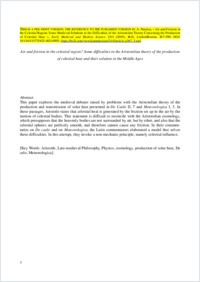Air and Friction in the Celestial Region: Some Medieval Solutions to the Difficulties of the Aristotelian Theory Con-cerning the Production of Celestial Heat
BHAP-PH
- Panzica, Aurora Université de Fribourg
-
2019
Published in:
- Early Medieval and Modern Science. - Brill. - 2019, vol. 24, no. 4, p. 367-390
Aristotle
Late-medieval Philosophy
Physics
cosmology
production of solar heat
De celo
Meteoro-logica
English
This paper explores the medieval debates raised by problems with the Aristotelian theory of the pro-duction and transmission of solar heat presented in De Caelo II, 7 and Meteorologica I, 3. In these passages, Aristotle states that celestial heat is generated by the friction set up in the air by the motion of celestial bodies. This statement is difficult to reconcile with the Aristotelian cosmology, which pre-supposes that the heavenly bodies are not surrounded by air, but by ether, and also that the celestial spheres are perfectly smooth, and therefore cannot cause any friction. In their commentaries on De caelo and on Meteorologica, the Latin commentators elaborated a model that solves these difficulties. In this attempt, they invoke a non- mechanic principle, namely celestial influence.
- Faculty
- Faculté des lettres et des sciences humaines
- Department
- Département de Philosophie
- Language
-
- English
- Classification
- Philosophy, psychology
- License
- License undefined
- Identifiers
-
- RERO DOC 330624
- DOI 10.1163/15733823-00244P03
- Persistent URL
- https://folia.unifr.ch/unifr/documents/309544
Statistics
Document views: 98
File downloads:
- ESM_Air-and-friction_Panzica_v2.pdf: 93
